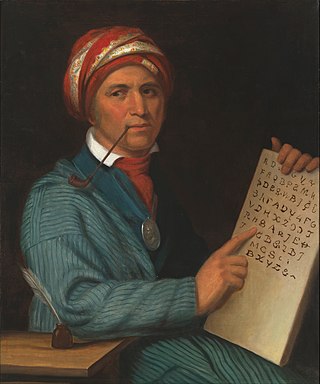
The Cherokee people are one of the Indigenous peoples of the Southeastern Woodlands of the United States. Prior to the 18th century, they were concentrated in their homelands, in towns along river valleys of what is now southwestern North Carolina, southeastern Tennessee, southwestern Virginia, edges of western South Carolina, northern Georgia and northeastern Alabama consisting of around 40,000 square miles.

The term Five Civilized Tribes was applied by the United States government in the early federal period of the history of the United States to the five major Native American nations in the Southeast: the Cherokee, Chickasaw, Choctaw, Muscogee (Creek), and Seminoles. White Americans classified them as "civilized" because they had adopted attributes of the Anglo-American culture.
Conventionally, the descriptor 'civilized' is seldom utilized nowadays due to its derogatory nature, and the historical usage of the term as an obscuration for cultural imperialism. Therewith, the grouping of these aforementioned nations is referred to as The Five Tribes or simply Five Tribes.
The Dawes Rolls were created by the United States Dawes Commission. The commission was authorized by United States Congress in 1893 to execute the General Allotment Act of 1887.
The American Dawes Commission, named for its first chairman Henry L. Dawes, was authorized under a rider to an Indian Office appropriation bill, March 3, 1893. Its purpose was to convince the Five Civilized Tribes to agree to cede tribal title of Indian lands, and adopt the policy of dividing tribal lands into individual allotments that was enacted for other tribes as the Dawes Act of 1887. In November 1893, President Grover Cleveland appointed Dawes as chairman, and Meridith H. Kidd and Archibald S. McKennon as members.
The Eastern Band of Cherokee Indians (EBCI), is a federally recognized Indian tribe based in western North Carolina in the United States. They are descended from the small group of 800–1,000 Cherokees who remained in the Eastern United States after the U.S. military, under the Indian Removal Act, moved the other 15,000 Cherokees to west of the Mississippi River in the late 1830s, to Indian Territory. Those Cherokees remaining in the east were to give up tribal Cherokee citizenship and to assimilate. They became U.S. citizens.
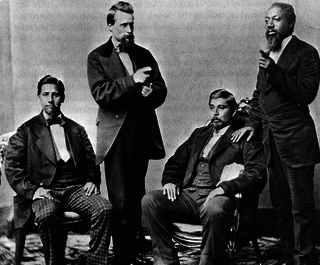
Blood quantum laws or Indian blood laws are laws in the United States that define Native American status by fractions of Native American ancestry. These laws were enacted by the federal government and state governments as a way to establish legally defined racial population groups. By contrast, many tribes do not include blood quantum as part of their own enrollment criteria. Blood quantum were first imposed by white settlers in the 18th century. Blood Quantum (BQ) is a very controversial topic.

The United Keetoowah Band of Cherokee Indians in Oklahoma is a federally recognized tribe of Cherokee Native Americans headquartered in Tahlequah, Oklahoma. According to the UKB website, its members are mostly descendants of "Old Settlers" or "Western Cherokees," those Cherokees who migrated from the Southeast to present-day Arkansas and Oklahoma around 1817. Some reports estimate that Old Settlers began migrating west by 1800, before the forced relocation of Cherokees by the United States in the late 1830s under the Indian Removal Act.
Black Indians are Native American people – defined as Native American due to being affiliated with Native American communities and being culturally Native American – who also have significant African American heritage.
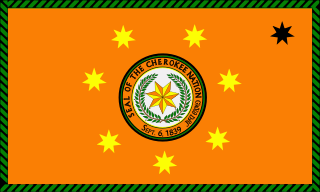
The Cherokee Nation, formerly known as the Cherokee Nation of Oklahoma, is the largest of three federally recognized tribes of Cherokees in the United States. It includes people descended from members of the Old Cherokee Nation who relocated, due to increasing pressure, from the Southeast to Indian Territory and Cherokees who were forced to relocate on the Trail of Tears. The tribe also includes descendants of Cherokee Freedmen, Absentee Shawnee, and Natchez Nation. As of 2023, over 450,000 people were enrolled in the Cherokee Nation.

The Keetoowah Nighthawk Society was a Cherokee organisation formed ca. 1900 that intended to preserve and practice traditional "old ways" of tribal life, based on religious nationalism. It was led by Redbird Smith, a Cherokee National Council and original Keetoowah Society member. It formed in the Indian Territory that was superseded by admission of Oklahoma as a state, during the late-nineteenth century period when the federal government was breaking up tribal governments and communal lands under the Dawes Act and Curtis Act. The Nighthawks arose in response to weakening resolve on the part of Cherokee leaders—including the original Keetoowah Society, a political organization created by Cherokee Native American full bloods, in or about 1859—to continue their resistance on behalf of the Cherokee after the Dawes Commission began forcing the transfer of Oklahoma tribal lands in the Indian Territory to individual ownership in the 1890s.
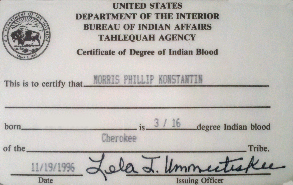
A Certificate of Degree of Indian Blood or Certificate of Degree of Alaska Native Blood is an official U.S. document that certifies an individual possesses a specific fraction of Native American ancestry of a federally recognized Indian tribe, band, nation, pueblo, village, or community. They are issued by the Bureau of Indian Affairs after the applicant supplies a completed genealogy with supporting legal documents such as birth certificates, showing their descent, through one or both birth parents, from an enrolled Indian or an Indian listed in a base roll such as the Dawes Rolls. Blood degree cannot be obtained through adoptive parents. The blood degree on previously issued CDIBs or on the base rolls in the filer's ancestry are used to determine the filer's blood degree. Information collected for the filing is held confidential by privacy laws, except if the CDIB is related to assigned duties.
The Original Keetoowah Society is a 21st-century Keetoowah religious organization dedicated to preserving the culture and teachings of the Keetoowah Nighthawk Society in Oklahoma. It has been described as the surviving core of the Cherokee movement of religious nationalism originally led by Redbird Smith in the mid-nineteenth century. After the Cherokee were forced to move to Indian Territory, various groups associated with the Keetoowah Society worked to preserve traditional culture and its teachings.
The Cherokee Freedmen controversy was a political and tribal dispute between the Cherokee Nation of Oklahoma and descendants of the Cherokee Freedmen regarding the issue of tribal membership. The controversy had resulted in several legal proceedings between the two parties from the late 20th century to August 2017.
Cherokee heritage groups are associations, societies and other organizations located primarily in the United States. Such groups consist of persons who do not qualify for enrollment in any of the three federally recognized Cherokee tribes. As the Cherokee Nation enrolls all people who can prove descent from a Cherokee ancestor, many of these groups consist of those who claim Cherokee ancestry but have no documentation to prove this alleged heritage. Some have had their claims of ancestry checked and proven to be false. A total of 819,105 Americans claimed Cherokee heritage in the 2010 Census, more than any other named tribe in the Census.
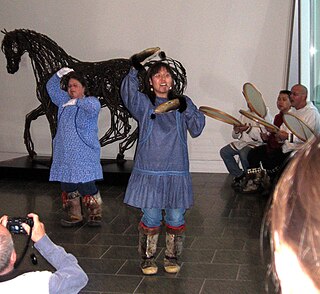
Native American identity in the United States is a community identity, determined by the tribal nation the individual or group belongs to. While it is common for non-Natives to consider it a racial or ethnic identity, for Native Americans in the United States it is considered to be a political identity, based on citizenship and immediate family relationships. As culture can vary widely between the 574 extant federally recognized tribes in the United States, the idea of a single unified "Native American" racial identity is a European construct that does not have an equivalent in tribal thought.

Native American recognition in the United States, for tribes, usually means being recognized by the United States federal government as a community of Indigenous people that has been in continual existence since prior to European contact, and which has a sovereign, government-to-government relationship with the Federal government of the United States. In the United States, the Native American tribe is a fundamental unit of sovereign tribal government. This recognition comes with various rights and responsibilities. The United States recognizes the right of these tribes to self-government and supports their tribal sovereignty and self-determination. These tribes possess the right to establish the legal requirements for membership. They may form their own government, enforce laws, tax, license and regulate activities, zone, and exclude people from tribal territories. Limitations on tribal powers of self-government include the same limitations applicable to states; for example, neither tribes nor states have the power to make war, engage in foreign relations, or coin money.

Andrea Lee Smith is an American academic, feminist, and activist. Smith's work has primarily focused on issues of violence against women of color and their communities, specifically Native American women. Formerly an assistant professor of American Culture and Women's Studies at the University of Michigan in Ann Arbor, Michigan, she is also a co-founder of INCITE! Women of Color Against Violence, the Boarding School Healing Project, and the Chicago chapter of Women of All Red Nations.

The Choctaw Freedmen are former enslaved Africans, Afro-Indigenous, and African Americans who were emancipated and granted citizenship in the Choctaw Nation after the Civil War, according to the tribe's new peace treaty of 1866 with the United States. The term also applies to their contemporary descendants.
In the United States, tribal disenrollment is a process by which a Native American individual loses citizenship or the right to belong within a Native American tribe.
The Baker Roll of the Eastern Band of Cherokee Indians was created by the Eastern Cherokee Enrolling Commission after it was commissioned by the United States Congress on June 4, 1924. The purpose of the Baker Roll was to collect and compile data from older Eastern Cherokee censuses and determine tribal affiliation. The roll is named after Special Agent Fred A. Baker.